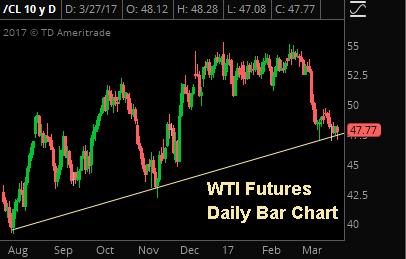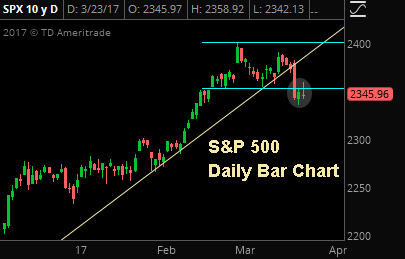Archive for month: March, 2017
Time to Buy Emerging Markets? March 29, 2017
/in Investing/by Tom EssayeThe Case for Emerging Markets, an excerpt from today’s Sevens Report. Everything you need to know about the market in your inbox by 7am, in 7 minutes or less.
 As expectations for a pro-growth policy based reflation trade (i.e. the Trump trade) fade here in the US, one potential beneficiary is emerging markets. The sector has underperformed since the election due to a combination of
As expectations for a pro-growth policy based reflation trade (i.e. the Trump trade) fade here in the US, one potential beneficiary is emerging markets. The sector has underperformed since the election due to a combination of
1) Dollar strength,
2) Rising US bond yields, and
3) Fear of trade wars.
But, if we see an extended pause in the dollar and bond yield rally, and continued poor execution on pro-growth policies, then emerging markets offer value in an otherwise expensive market.
Now, I’m not saying I’m a long-term bull on emerging markets, nor does this analysis mean I’m not a long-term bull on the dollar or bond yields… I think both go higher long term.
However, the fact is this market has already priced in a an acceleration of growth in the US. If that doesn’t materialize, we could see a sideways chop in the dollar and bond yields, and emerging markets will likely outperform near term (i.e. the next few months).
The investment thesis behind EM is comprised of three pillars: Valuation, inverse correlation to the US-based reflation trade, and positive exposure to global growth.
Pillar 1: Attractive Relative Valuation. Emerging markets are much cheaper than most developed markets, as several research pieces we’ve read have emerging markets trading 12X forward P/E, compared to 17X and 15X for the US and Europe, respectively. So, there is value there, especially after the under-performance following the election.
Pillar 2: Hedge Against a Reflation Trade Unwind. If we see the reflation trade continue to unwind (which started in earnest last Tuesday) then emerging markets will benefit. Case in point, since the election, our preferred emerging market ETF (withheld for subscribers) has returned 5.9%. But, almost all of those gains have come over the past few weeks thanks to the Fed’s dovish hike, and the healthcare failure.
If reflation trade enthusiasm wanes in the US, emerging markets will continue to benefit thanks to the weaker dollar and lower yields. To put it simply, emerging market returns are highly inversely correlated to the dollar. If we see the dollar continue to grind sideways or continue to fall, emerging markets should outperform.
Pillar 3: Positive Exposure to Global Growth. Finally, emerging markets should benefit from a rising global economic tide. US rate hikes aside, the rest of the world’s central banks remain very “easy,” and generally speaking global growth is on an upswing… and that should continue to benefit emerging markets. There are, however, risks to the trade. First, if we get border adjustments in a corporate tax cut package, that’s negative EM because it effectively puts a tax on all emerging market exports (i.e. raw materials), which will reduce demand. Second, if the Fed becomes more hawkish near term, then the dollar and bond yields will rise, and EM will lag. Third, if China sees another growth scare that will hurt EM. Finally, if the Trump administration begins to levy import taxes or engages in aggressive trade policies, that will obviously be EM negative. Of these risks, we view the most probable as the Fed getting more hawkish. But, near term that just isn’t very likely. So, the risks to this strategy are real, but we don’t view them as imminent.
Finally, I’m not saying emerging markets are a long-term strategy, but I do think EM is something that can outperform over the coming months, especially if we see a lack of progress on tax cuts. As such, EM offers reasonable upside in a market where not much is cheap, and we think the potential reward is worth the risk.
How to Play It
Reserved for subscribers of the Sevens Report. Sign up for your free 2-week trial to access our preferred ETF’s.
For a monthly cost of less than one client lunch, we firmly believe we offer the best value in the independent research space. Get your free trial of the Sevens Report today.
Tax Cut Primer (What You Need to Know), March 28, 2017
/in Investing/by Tom EssayeWith healthcare shelved, focus now will turn to the truly important topic for markets: Corporate tax cuts. This is an excerpt from today’s Sevens Report. You can sign up for your free trial at 7sReport.com—everything you need to know about the markets in your inbox by 7am, in 7 minutes or less.
I’ve covered this a lot so far this year, but I wanted to dedicate a special section today for a tax cut primer that you can refer back to as this process unfolds over the coming months.
Going forward, there are two key points to understand. First, in order for tax cuts to be a bullish gamechanger (i.e. push the S&P 500 materially above 2400) they must drop the nominal rate to 20% or below. That will provide the expected $10-$12 EPS boost for the S&P 500 in 2018 that will help stocks break out, because at $146 S&P 500 EPS (the current $134 2018 expectation, plus an additional $12 from tax cuts) the S&P 500 would be cheap at 16X 2018 earnings.
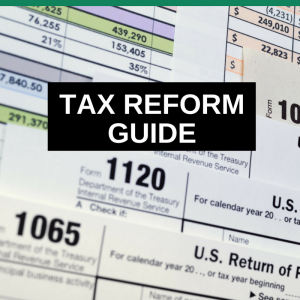 Second, tax cuts will be a bearish gamechanger if the market begins to believe: 1) They won’t happen at all, or 2) They will be so small that it won’t make a difference. Point being, tax cuts can be delayed in 2018 and it won’t be a bearish game changer as long as the market still expects that rate to be cut to 20% or lower.
Second, tax cuts will be a bearish gamechanger if the market begins to believe: 1) They won’t happen at all, or 2) They will be so small that it won’t make a difference. Point being, tax cuts can be delayed in 2018 and it won’t be a bearish game changer as long as the market still expects that rate to be cut to 20% or lower.
So, to stay ahead of the tape we need to figure out what must happen to get material corporate tax reform passed. To that point, there is one issue that is the key to whether material tax reform gets passed: Border adjustments.
Here’s why border adjustments are key: Dropping the corporate tax rate from 35% to 20% would mean a big loss of revenue for the government, so that needs to be offset otherwise the deficit will explode. A plan that does not have an offset will not be passed despite the Republican-controlled government.
To that point, the Tax Policy Center estimates that implementing border adjustments would generate $1.2 trillion in additional tax revenue over 10 years, which is two-thirds of the $1.8 trillion in lost revenue that would occur if the corporate tax rate drops to 20% from 35%. It’s the key to getting tax cuts at least somewhat revenue neutral.
I’m not going to get into the nitty-gritty details of what border adjustments are, because I’ll put everyone to sleep. But generally, border adjustments have to do with changing the way US corporations are taxed on overseas sales and purchases. To use a simple-but-imperfect analogy, border adjustments are similar to import taxes (they aren’t the same, but for purposes of illustration the comparison makes my point).
The problem for markets is that there appears to be even bigger disagreement on border adjustments within the Republican party than there was on healthcare, so right now there is no credible path to material corporate tax reform. This is especially true after the healthcare fight created additional resentment within the party.
Bottom line, without a border adjustment compromise, there’s very little chance the corporate tax rate can be dropped to 20%, and provide the earnings boost to push stocks higher.
Going forward, a key name to watch is Kevin Brady. Brady is the House Ways & Means Chairman (where tax legislation begins). A compromise on this issue won’t happen without him, so going forward we’re closely watching any comments or articles from Brady.
Sector Winners & Losers of Tax Cuts/Border Adjustments
(ETF’s withheld for subscribers. Sign up for your free two-week trial at 7sReport.com.)
Bottom line, for fiscal stimulus to push stocks further, we have to have meaningful corporate tax cuts (20% or lower). For tax cuts to be that powerful, there has to be compromise on border adjustments, and right now, there are no signs of compromise (although again the market will likely give Republicans the benefit of the doubt till Memorial Day).
Last Week and This Week in Economics, March 27, 2017
/in Investing/by Tom Essaye
“Last Week and This Week in Economics”—an excerpt from today’s Sevens Report: everything you need to know about the markets in your inbox by 7am, in 7 minutes or less.
For all of 2017, better-than-expected economic data has helped to offset the decreased likelihood of pro-growth policies from Washington, and that continued last week as what little economic data we did receive was generally supportive for stocks.
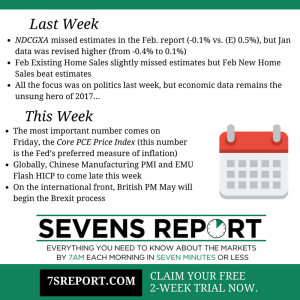 Looking at Durable Goods, longer-term readers know we ignore the headline and look straight for New Orders for Non-Defense Capital Goods ex-Aircraft (NDCGXA). That is the better measure of business spending, as the headline Durable Goods order is massively skewed by the timing of aircraft orders.
Looking at Durable Goods, longer-term readers know we ignore the headline and look straight for New Orders for Non-Defense Capital Goods ex-Aircraft (NDCGXA). That is the better measure of business spending, as the headline Durable Goods order is massively skewed by the timing of aircraft orders.
NDCGXA missed estimates in the Feb. report (-0.1% vs. (E) 0.5%), but the January data was revised higher (from -0.4% to 0.1%). So, that largely offsets the miss in February.
The March flash manufacturing PMI was a disappointment, as it missed estimates and hit a surprise six-month low at 53.2 vs. (E) 54.3. But while disappointing, the flash PMI forecasted weakness in February that didn’t appear in other national manufacturing PMIs, and even at 53.2, that’s still a decent absolute number (remember, anything above 50 shows activity accelerating). Point being, that one number doesn’t suggest a loss of momentum.
Looking at other data, February Existing Home Sales slightly missed estimates but February New Home Sales beat estimates. But, with housing it’s helpful to step back from the monthly data and observe the overarching trend, and that trend is stability. All the housing data confirms that so far. Higher mortgage rates are now causing a noticeable slowdown in the housing recovery, and that remains key un-sung support for the economy.
Turning to the Fed, there were multiple speakers last week, but the headliner was Fed Chair Yellen, who made no comments about the economy or policy during her speech. Other Fed members were on balance slightly hawkish, as many of them referenced hiking three or four times this year, but none of it was impactful enough to reverse the dollar or Treasury yield decline we’ve seen since the Fed’s dovish hike in March. Markets still have a June rate hike at about a 50/50 proposition, unchanged from last week.
Bottom line, all the focus was on politics last week, but economic data remains the unsung hero of 2017, and it continues to help offset growing policy headwinds via Washington.
This Week
This week will be another relatively quiet week from an economic standpoint, and once again the most important number won’t come until Friday.
That number is the Core PCE Price Index contained in the Personal Income and Outlays report. That’s important because it’s the Fed’s preferred measure of inflation, and if the headline PCE Price Index breaks through 2.0% yoy (last 1.9%), and the Core PCE Price Index moves further towards 2.0% (last 1.7%), that may elicit a slightly hawkish reaction in markets.
Internationally, there are two notable reports to watch. First, Chinese Manufacturing PMI hits Thursday night, and while China remains on the back burner from a macro standpoint, any signs of economic slowing will surprise markets. Second, EMU Flash HICP (their CPI) comes Friday. The best outcome for European stocks is a Goldilocks number, where core inflation doesn’t rise much from the current 0.9% yoy pace, and as such doesn’t make the ECB think about ending QE prematurely. A Goldilocks number will be positive for European ETFs (HEDJ, VGK, EZU).
Bottom line, this will be another quiet week from a data standpoint, but the numbers need to confirm the acceleration of growth to continue to support stocks. From a risk standpoint, too-strong HICP or Core PCE numbers are the events to watch (they might make the Fed and ECB lean more hawkish).
Politically, there will be a lot of analysis on the shift towards tax cuts (we’ll do a primer this week), but nothing truly important is scheduled. Finally, on the international front, British PM May will formally trigger Article 50 to begin the Brexit process (although that shouldn’t cause much volatility).
Help your clients outperform markets with the Sevens Report. Claim your free trial today: 7sReport.com.
Tom Essaye on “The Bell” Podcast with Danielle Dimartino, author of FED UP
/in Investing/by Tom EssayeThanks to Adam Johnson of BullseyeBrief.com for having me on “The Bell” podcast. This week we talked about oil, the healthcare bill, and the seemingly endless rise of stocks.
We were also joined by author Danielle Dimartino, who told us a little bit about her new book FED UP, which talks about some major flaws she noticed during her nine years working for the Fed. It’s a great read—check it out.
For a free two-week trial of the Sevens Report, visit www.7sReport.com.
Healthcare Vote: Macro and Micro Implications, March 23, 2017
/in Investing/by Tom EssayeJoin hundreds of advisors from huge brokerage firms like Morgan Stanley, Merrill Lynch, Wells Fargo Advisors, Raymond James and more… see if the Sevens Report is right for you.
The healthcare vote in the House later today will have an effect on stocks in the short and long term, regardless of the outcome, so I wanted to run down the various scenarios along with sector winners and losers depending on whether the bill passes or fails.
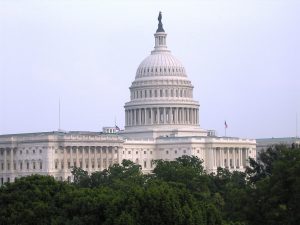
Healthcare Vote: Macro and Micro Implications
Scenario #1: Bill Passes
Likely Short-Term Market Reaction: Knee-jerk, risk-on rally that likely will see cyclical sectors outperform.
Impact On Other Assets: Dollar up/bonds down/gold down/commodities down (all due to the perceived increased likelihood of tax cuts). Basically, this would be a short-term reignition of the “reflation trade/Trump-on trade” that’s driven markets higher since the election.
Likely Long-Term Market Reaction: Not a bullish game changer. Despite the likely positive reception by the market, this event by itself won’t be a catalyst for the market to move new highs. That’s because even if the healthcare law passes the House, it still has little-to-no chance of passing the Senate, and as such probably won’t become law. So, while it would be an incremental step towards the ultimate goal of corporate tax cuts, it still wouldn’t be material progress. Longer term, this outcome wouldn’t make me add or reduce stock exposure… it would elicit a “wait and see” response.
Effect on the Healthcare Sector and ETFs: This section is for subscribers only. You can sign up for a free trial to access at 7sReport.com.
Next Important Event in this Scenario: Memorial Day. If the bill passes the House, then markets will give the Republicans more of a benefit of the doubt. However, healthcare needs to be done by late April/early May (or Memorial Day at the latest) if corporate tax cuts can be completed in 2017, so the clock will soon be ticking.
Scenario #2: Bill Fails
Likely Short-Term Market Reaction: A resumption of Tuesday’s sell-off. Cyclical sectors led by banks would likely pull markets lower, and a drop down through sup-port at 2300 in the S&P 500 would not be at all surprising by the end of the week. Defensive sectors would out-perform.
Impact On Other Assets: Dollar down (likely big)/bonds up (10 year yield could break down through 2.30%)/gold up (likely big)/commodities up (all due to the perceived reduced likelihood of tax cuts). Basically, this would cause a short-term reversal of the “reflation trade/Trump-on trade” that’s driven markets higher since the election, and we can expect a similar trading pattern to Tuesday.
Effect on the Healthcare Sector: This section is for subscribers only. You can sign up for a free trial to access at 7sReport.com.
Next Important Event in This Scenario: Memorial Day. If the bill fails, the market will hope Republicans pivot and focus on tax cuts, and perma bulls will herald that as a positive. However, make no mistake, a failure of this bill to pass is not a positive for tax cuts, where the fight over border adjustments will make healthcare look tame. Regardless, if there is a pivot to tax cuts, then there needs to be concrete motion on a tax cut bill by Memorial Day, otherwise markets will begin to doubt tax cuts in 2017, which will be a market negative.
The Sevens Report is the daily market cheat sheet our subscribers use to keep up on markets, seize opportunities, avoid risks and get more assets. Start your free two-week trial today.


